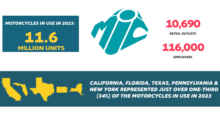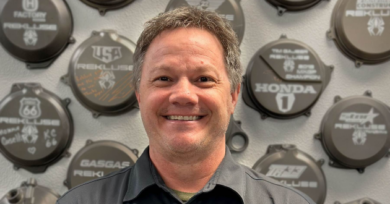Find income with F&I
Extra revenue and customer retention
are built with ancillary products
By Liz Hochstedler
Associate Editor
When most customers seek to purchase a motorcycle, ATV, UTV, snowmobile or PWC, they likely have an idea about what kind of unit they want and a general concept of how they want to pay for it. But many don’t know what kind of financing is available, how they plan on insuring the vehicle, or how they want to protect their investment.
F&I professionals and dealer consultants agree that dealers should sell as many F&I products as they can, so customers clearly understand their financing and insurance options, the dealership earns customers’ trust, and the store can profit from sales of the products. Popular options in F&I include financing, GAP insurance, vehicle insurance, extended service contracts, debt or credit protection, tire and wheel protection and theft deterrent products.
“There are a lot of F&I products, but … for every F&I product, there is somebody who needs it — you just have to present it,” said Steve Jones, project manager for Gart Sutton & Associates.
The more products that are offered, the more likely a customer is to choose at least a few, rather than turning down the one or two available.
“Even though people look at them as recreational vehicles, powersports products are getting more expensive by the year, and the F&I products are all designed for protecting a customer from a loss one way or another,” said Julia McCarthy of Aftercare.
Why is F&I important?
Dealers should carry F&I for two primary reasons: added revenue and customer satisfaction.
“The income is two ways — it’s income by driving more repairs back to your dealership that can grow service revenue, and, obviously, there is income in providing the products themselves,” said Christopher Bernish, vice president and general manager FPC, Protective Asset Protection Division and Protective Xtra Ride Powersports.
F&I has little overhead, except for training and certification of employees and for F&I personnel, for dealerships who field those positions. After that overhead is covered, all sales are profit. For example, an F&I product may have a $230 net cost, but the dealer can mark it up another $200 to maximize each sale.
“It really is profit. If it is professionally presented and presented to the right customer, the customer that can make use of it,” Jones said. “We have a number of dealers in our 20 Group that sell between $500 and $1,000 in products per vehicle sold, not just per vehicle financed. That’s pretty impressive.”
Dealers also see future profit with many of the products. With extended service contracts, pre-paid maintenance and tire and wheel protection, dealers often see customers return to the store time and again. Service can then profit on repairs above and beyond what the coverage plans offer, and the parts and accessories and sales departments can seek additional sales while the customer is in the dealership.
If an extended service contract is sold that runs two years beyond the one-year factory warranty, a dealer can almost guarantee to see that customer for an extended period of time, McCarthy explained.
“It’s the beginning of a three year relationship,” she said.
And often after or within that four-year period, customers will be ready to replace their unit and will return to the dealership with which they’ve become familiar.
The customer retention piece is important. Selling F&I builds a relationship of trust between a customer and a dealer because the customer feels the dealership has gone above and beyond to protect their investment, experts say.
“It protects the customer’s investment,” Bernish explained. “A customer with extended protection is more likely to come back to that dealership for repair service. They’re more likely to be satisfied in case of a failure.”
Surveys have shown that customers are more satisfied with dealers who can provide F&I products meant to protect their vehicle, Jones reported.
“If a dealer does not provide financing and other useful products, like extended service contracts or GAP for larger ticket products, many customers will buy elsewhere,” he said. “It is important for a dealer to be a one-stop shop and provide all the products and services a customer might need or want.”
Also, because F&I products are offered after the sale, many are sold without much haggling or concern about competition. Customers usually don’t compare F&I rates from dealership to dealership.
Products offered
The primary product offered by the F&I department is financing. If a vehicle can’t be financed, it often can’t be sold, which not only stops the sale from happening, but also affects the sales in all other departments.
“The key to it — the real biggie — is they have to be able to finance the unit. If they can’t finance it, those other [F&I] products can’t be sold,” Jones said.
Customers may also buy more expensive vehicles and possibly add-ons if their financing fits into their budget, explained Jeff Karls, vice president of marketing for GE Money.
“Financing makes a customer’s purchase affordable,” he added. “It gives customers the confidence to make their purchase now versus waiting until they have cash available. By offering financing — especially promotional financing — dealers can draw more customers to their store, close more sales, sell higher-end products and add more accessories to a sale all before a customer checks out the competition.”
Dealers should also consider financing vehicles themselves, and not relying solely on bank and credit union financing, Jones said.
When the vehicle is sold, all other F&I products can be offered. Insurance allows vehicles to be used immediately in states that require it. Extended service contracts, warranties and tire and wheel protection keep the vehicle in running order, and GAP insurance protects the customer’s large investment in case of a theft or crash. Theft deterrents physically protect the vehicle in public, and credit and debt protection helps customers in case of financial difficulties.
Overcoming the fear
Despite the benefits of F&I, many dealerships are still hesitant to offer the products to their customers. McCarthy estimates 40-50 percent of dealers don’t actively sell F&I.
“It is just not in their comfort zone,” Karls said. “Most folks in dealerships are there because they love powersports equipment. Financing is not the exciting part of the business, but it is part of the basics to make a powersports sale.”
The reasons for the lack of dedication to the department are plentiful, but the primary excuse given is the lack of training, Jones said. Many dealers don’t train staff on F&I. Other dealerships maintain one F&I staffer, but when that person leaves the dealership — either for the day or permanently — no one is trained to replace him or her. Other issues also persist.
“No. 1, in order to sell F&I products with any success, you have to believe in them,” Jones explained. “On my on-sites visits, I run into a number of dealers that just don’t understand the products or for some other reasons don’t believe in the product and don’t want to sell them.”
The lack of belief in the products may have originated with a dealer’s own bad experience with such products at an auto dealership. Or it might have come from a dealer not fully understanding the benefits to both the dealership and its customers. The easiest way to overcome these hurdles is for dealers to grasp how F&I can help their business and for other managers to understand it as well.
“The primary solution is to have very strong management, and the management needs to communicate their commitment to the customers,” McCarthy said.
The management then has to provide its staff with the tools to sell F&I, such as computer systems, menus and/or waivers, so management knows each customer is offered F&I products or has at least seen a presentation of the available products.
F&I products have become especially important as the economy has affected overall unit sales. With each F&I sale, profits can be compounded, and though not as many vehicles are being sold as in the heydays of the mid-2000s, increased sales can still be found.
“It was always important, but I think it’s more important today,” Bernish said. “I think it’s important to maximize the revenue stream for every unit that the dealer sells.”








